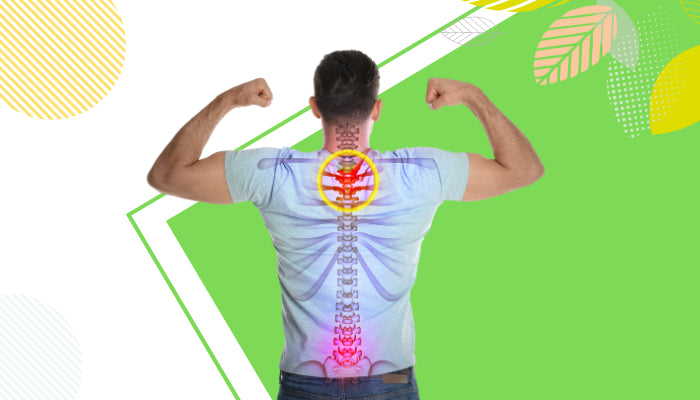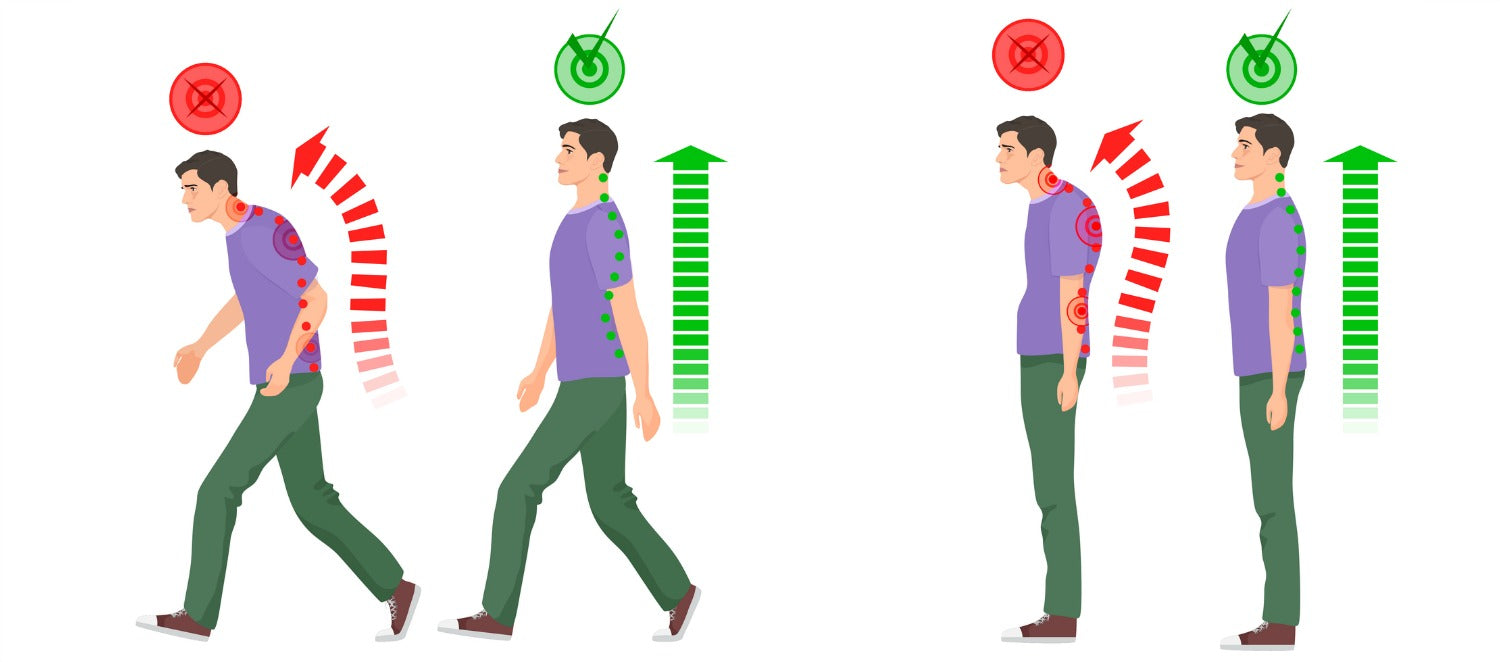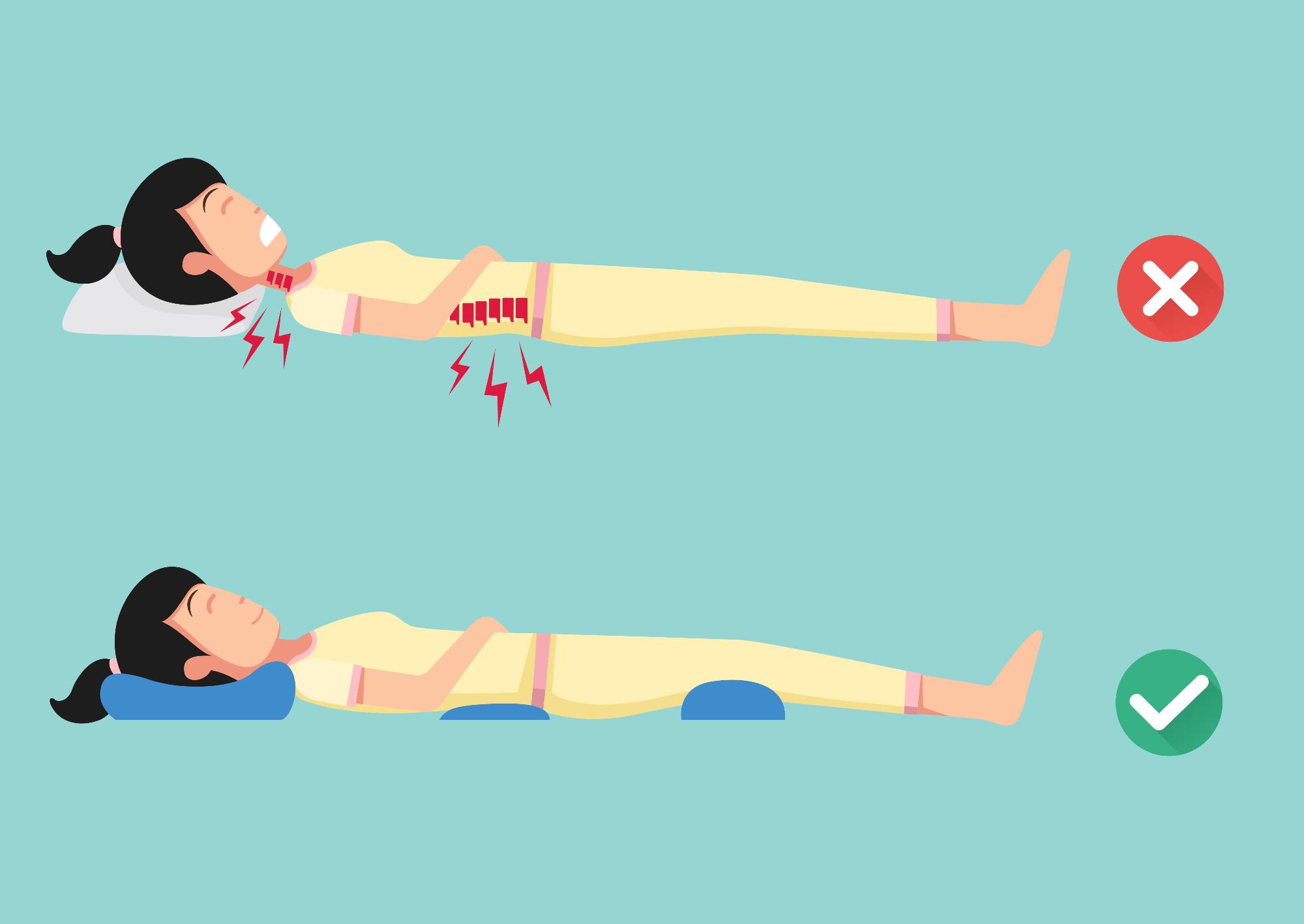Your Cart is Empty

দীর্ঘ দিন পর কখনও আপনার পিঠে অভিযোগ অনুভব করেছেন? ভাবছেন যে পিঠের ব্যথায় লাথি মারার উপায় আছে কিনা? পিঠে ব্যথার চিকিত্সা খুঁজছেন যা আসলে কাজ করে এবং আপনাকে ব্যথা ছাড়াই চলাফেরার স্বাধীনতা পুনরুদ্ধার করতে দেয়?
আমরা বুঝি। পিঠের ব্যথা শারীরিক এবং মানসিক উভয়ভাবেই একটি টোল নিতে পারে। ভাল খবর হল ব্যথা পরিত্রাণ পেতে একাধিক পদ্ধতি আছে। তাহলে, আপনি কীভাবে সেই পিঠের ব্যথা থেকে মুক্তি পাবেন? সেই ব্যথা উপশম পদ্ধতি কি কি?
চিন্তা করবেন না। এই নিবন্ধটি কেবল পিঠের ব্যথা থেকে মুক্তি পাওয়ার দশটি উপায় কভার করবে না; আমরা ব্যথার উপসর্গ, এর কারণ, প্রকার এবং এটিকে প্রতিরোধ করার উপায় নিয়েও আলোচনা করব। তাই, কেন অপেক্ষা? এর থেকে ত্রাণ পেতে এটি অন্বেষণ করা যাক।
পিঠের ব্যথার সাথে মোকাবিলা করা এমন কিছু যা আমরা সকলেই অতিক্রম করি। ভাগ্যক্রমে, ব্যথা কমানোর বিভিন্ন উপায় রয়েছে। এখন, এই পিঠ ব্যথা চিকিত্সা পদ্ধতি আলোচনা করা যাক.
বিশেষজ্ঞদের দ্বারা পরিচালিত উপযোগী শারীরিক থেরাপির রুটিনগুলি পিঠের ব্যথা কমানোর জন্য গুরুত্বপূর্ণ। এটা শুধু ব্যায়াম সম্পর্কে নয়; এটি অঙ্গবিন্যাস নিখুঁত করা এবং আপনার মূলকে শক্তিশালী করার বিষয়ে —শুধুমাত্র আপনার জন্য ব্যক্তিগতকৃত।
ধারাবাহিকতা অগ্রগতির চাবিকাঠি। সেশনের মধ্যে হোম ওয়ার্কআউট রুটিনগুলি বজায় রাখা শরীরকে আরও অনায়াসে লাভগুলিকে অন্তর্ভুক্ত করতে দেয়। দীর্ঘস্থায়ী পিঠের ব্যথার জন্য কিছু শারীরিক থেরাপি অন্তর্ভুক্ত করতে পারে:
ওষুধ গ্রহণ চলমান পিঠের ব্যথা কমাতে সাহায্য করতে পারে, তবে বিবেচনা করার জন্য খারাপ দিক রয়েছে। আপনাকে আসক্তির ঝুঁকি, সম্ভাব্য পার্শ্বপ্রতিক্রিয়া এবং অন্তর্নিহিত সমস্যাগুলি ঢেকে রাখার সুযোগ বিবেচনা করতে হবে।
হার্ভার্ড হেলথ পাবলিশিং -এর মতে , পিঠের ব্যথার জন্য কিছু কার্যকর ওষুধ হল NSAIDs, Opioids, পেশী শিথিলকারী ইত্যাদি। তবে, নির্ভরতা রোধ করার জন্য শুধুমাত্র প্রয়োজন হলে ওপিওডের মতো ওষুধ ব্যবহার করা ভাল।
দ্রুত ত্রাণের জন্য সর্বোচ্চ মাত্রার চেয়ে ক্ষুদ্রতম কার্যকর পরিমাণের জন্য লক্ষ্য রাখুন। প্রথমে অ-ড্রাগ বিকল্পগুলি চেষ্টা করুন। এছাড়াও, আপনার প্রত্যাশাগুলি বাস্তবসম্মত রাখুন এবং আরও তীব্র চিকিত্সার দিকে যাওয়ার আগে অন্যান্য বিকল্পগুলি অন্বেষণ করুন।
দীর্ঘস্থায়ী ব্যথার জন্য ইনজেকশন থেরাপি পাওয়া যায়। এর মধ্যে রয়েছে নার্ভ ব্লক, এপিডুরাল স্টেরয়েড ইনজেকশন এবং নার্ভ অ্যাবলেশন। অন্যান্য পদ্ধতিগুলি কাজ না করলে এবং ব্যথার কারণ জানা গেলে তারা সহায়ক হতে পারে।
ইনজেকশনগুলি একটি নির্দিষ্ট সময়ের জন্য ব্যথা বন্ধ করতে এবং কমাতে পারে, তবে সময়ের সাথে সাথে তাদের কার্যকারিতা হ্রাস পায়। মনে রাখবেন, এই চিকিত্সাটি একটি স্বতন্ত্র চিকিত্সা হিসাবে ব্যবহার করা উচিত নয় এবং এটি একটি স্থায়ী সমাধানের জন্য নয়।
আপনি যখন দীর্ঘস্থায়ী ব্যথার সাথে মোকাবিলা করছেন তখন আপনার সীমাগুলি জানা এবং সেই অনুযায়ী একটি জীবনধারা গ্রহণ করা গুরুত্বপূর্ণ। ভারী উত্তোলন, দীর্ঘ সময় ধরে বসে থাকা বা দাঁড়ানো এবং চাপকে উপেক্ষা করার মতো ব্যথা-বাড়ন্ত ক্রিয়াকলাপগুলি সনাক্ত করুন। সম্ভব হলে তাদের এড়িয়ে চলুন। এটি আপনার পিঠের উন্নতি করবে এবং অবস্থার অবনতি রোধ করবে।
বিবেচনা করার জন্য আরেকটি লক্ষণীয় জীবনধারা সমন্বয় হল ধূমপান ত্যাগ করা। নিকোটিন গবেষণায় পাওয়া গেছে যে ব্যথা আরও খারাপ হয় এবং নিরাময় বিলম্বিত হয়। ধূমপান ত্যাগ করা আপনাকে স্বাস্থ্যকর জীবনযাপনে সাহায্য করবে।
আমরা যে স্ট্রেনের মধ্য দিয়েছিলাম তার কারণে আমাদের পিঠগুলি বছরের পর বছর ধরে কিছু অসাধারন অভ্যাস তৈরি করেছে। কিন্তু কৌশলটি এখানে: প্রপস হিসাবে বালিশ ব্যবহার করা আমাদের মেরুদণ্ডকে আরও নমনীয় করে তুলতে পারে। এটি কাজের দীর্ঘ সময় থেকে চাপ কমাতে পারে। 
অস্বস্তি এবং অতিরিক্ত ক্ষতি রোধ করতে আপনার পিছনের পেশীগুলিকে সঠিক ভঙ্গিতে গাইড করুন । ধারাবাহিকভাবে অনুশীলন করলে ছোট সমন্বয় যোগ হয়। সুতরাং, এই কাঁধগুলি শিথিল করুন, সোজা হয়ে বসুন এবং আপনার চেয়ারটিকে আপনার পিঠকে সমর্থন করতে দিন।
আপনার পিঠে ব্যথা হলে ঘুমানো কঠিন। খারাপ কি? এই ঘুমের অভাব আপনার পিঠের ব্যথাকে আরও খারাপ করতে পারে , একটি অন্তহীন লুপ তৈরি করে। খারাপ ঘুমের অবস্থানও পিঠে ব্যথার কারণ হতে পারে। 
ভাল ঘুমের জন্য, আপনার পাশে বিশ্রাম করার চেষ্টা করুন। নিরপেক্ষ মেরুদণ্ড এবং পিঠের ত্রাণের জন্য আপনার হাঁটুর মধ্যে একটি বালিশ ব্যবহার করুন। আপনার হাঁটুর নীচে একটি বালিশ চেষ্টা করুন যদি আপনি পিছনে ঘুমান। একটি ভারসাম্যপূর্ণ এবং বিশ্রামের ঘুমের জন্য আরামদায়ক দৃঢ় একটি গদি চয়ন করুন।
কিছু খাদ্যতালিকাগত পছন্দ, যেমন ট্রান্স ফ্যাট, শর্করা এবং প্রিজারভেটিভ সমৃদ্ধ খাবার, প্রদাহ বাড়ায়। এছাড়াও, এটি দীর্ঘস্থায়ী পিঠের ব্যথাকে আরও খারাপ করতে পারে। আপনার খাদ্য আপনার দীর্ঘস্থায়ী পিঠের ব্যথা বাড়াচ্ছে কিনা এবং আপনি কীভাবে এটি পরিবর্তন করতে পারেন তা জানতে একজন পুষ্টিবিদের সাথে পরামর্শ করুন।
পর্যাপ্ত ক্যালসিয়াম এবং ভিটামিন ডি গ্রহণ ধ্রুবক স্ট্রেনের আবহাওয়ার কাঠামোকে পুষ্ট করে। একটি সুষম খাদ্য ওজন পরিচালনা করে, মেরুদণ্ডের লোডিং হ্রাস করে। আপনার মেরুদণ্ড শক্তিশালী এবং নমনীয় রাখতে বিশেষজ্ঞের পরামর্শ অনুসরণ করুন।
ধ্যান হল হতাশা, উদ্বেগ এবং চলমান পিঠে ব্যথার সাথে আসা অন্যান্য আবেগগুলি পরিচালনা করা। এটি দৃঢ়ভাবে প্রতিক্রিয়া না করে বা তাদের খারাপ না করে অনুভূতি সম্পর্কে সচেতন থাকার দক্ষতা তৈরি করে। মননশীলতা মানে বিচার না করে বা স্বয়ংক্রিয়ভাবে সাড়া না দিয়ে ব্যথা বা চাপ লক্ষ্য করা।
অনুভূতি পরিচালনায় সহায়তার জন্য পুনর্বাসন মনোবিজ্ঞানীর সাথে পরামর্শ করার কথা বিবেচনা করুন। ব্যথা থেকে আপনার ফোকাস সরিয়ে নিতে তারা ধ্যান বা তাই চি সুপারিশ করতে পারে। এটি আপনার পিঠের পেশীগুলিকে শক্তিশালী করতে পারে এবং ভঙ্গিমা উন্নত করতে পারে, তবে সতর্ক থাকুন যাতে ব্যথা আরও খারাপ না হয়।
আকুপাংচার, ম্যাসেজ, যোগব্যায়াম, চিরোপ্রাকটিক সামঞ্জস্য এবং পিঠের সার্জারি ধ্রুবক পিঠের ব্যথায় সাহায্য করতে পারে। আকুপাংচার, একটি চীনা অনুশীলন, প্রাকৃতিক ব্যথা উপশমের জন্য নির্দিষ্ট শরীরের অবস্থানে ক্ষুদ্র সূঁচ ব্যবহার করে। কেউ কেউ দাবি করেন যে এটি অস্বস্তি হ্রাস করে।
আঁটসাঁটতা, পেশী শিথিল করতে এবং সঞ্চালন বাড়াতে ম্যাসেজ হ্যান্ড-অন ম্যানিপুলেশন ব্যবহার করে। যোগব্যায়াম প্রসারিত, শক্তিশালীকরণ এবং চাপ উপশমের জন্য ভঙ্গি, শ্বাসপ্রশ্বাস এবং ধ্যানকে একত্রিত করে। স্ট্যান্ডার্ড চিকিত্সা কম হলে ডাক্তারের পরামর্শে এই বিকল্প পিঠের ব্যথার চিকিত্সাগুলি অন্বেষণ করুন।
আপনার সার্জন ডিস্কের কিছু উপাদান অপসারণ করার জন্য একটি ডিসসেক্টমির পরামর্শ দিতে পারেন যদি একটি স্নায়ুর উপর বুলিং ডিস্ক চাপ থাকে। কিছু ক্ষেত্রে, একটি ল্যামিনেক্টমির জন্য মেরুদন্ড বা স্নায়ুর উপর চাপ কমানোর প্রয়োজন হতে পারে।
যদিও মেরুদণ্ডের সংমিশ্রণ মেরুদণ্ডকে স্থিতিশীল করতে পারে, তবে এর ঝুঁকি রয়েছে এবং সবসময় সফল হয় না। এটি একটি শেষ অবলম্বন বিবেচনা করুন.
পিঠে ব্যথার লক্ষণগুলি পেশী ব্যথা থেকে শুরু করে গুলি, জ্বলন্ত বা ছুরিকাঘাতের ব্যথা পর্যন্ত হতে পারে। পিঠের ব্যথা পায়ে বিকিরণ করতে পারে বা নড়াচড়ার সাথে আরও খারাপ হতে পারে। বিশ্রাম এবং বাড়িতে চিকিত্সার মাধ্যমে হালকা পিঠের ব্যথার উন্নতি হতে পারে, তবে গুরুতর বা অবিরাম ব্যথার জন্য চিকিত্সার মনোযোগ প্রয়োজন।
কয়েক সপ্তাহ ধরে চলতে থাকা পিঠে ব্যথা বা উদ্বেগজনক লক্ষণগুলির জন্য একজন ডাক্তারের সাথে দেখা করুন যেমন:
পিঠে ব্যথা বিভিন্ন উত্স থেকে আসতে পারে এবং সব বয়সের মানুষকে প্রভাবিত করতে পারে। সাধারণ কারণগুলি জানা সঠিক সমাধান এবং চিকিত্সা খোঁজার জন্য একটি গুরুত্বপূর্ণ প্রথম পদক্ষেপ। এখানে পিঠে ব্যথার প্রধান কারণগুলির মধ্যে কয়েকটি রয়েছে:
খুব ভারী কিছু তোলা বা ভুল পথে মোচড়ানো আপনার পিছনের পেশী এবং লিগামেন্টগুলিকে অতিরিক্ত প্রসারিত করতে পারে। এই ধরনের স্ট্রেন হঠাৎ ঘটতে পারে এবং তীব্র ব্যথা হতে পারে।
অস্টিওআর্থারাইটিস (এক ধরনের আর্থ্রাইটিস) বা আপনার মেরুদণ্ডের ডিস্ক, জয়েন্ট বা হাড়ের হাড়ের স্পারের মতো অবস্থাগুলি এর গঠন পরিবর্তন করতে পারে এবং স্নায়ুর উপর চাপ দিতে পারে। মেরুদণ্ডে অস্টিওআর্থারাইটিস দেখা দেয় যখন তরুণাস্থি কমে যায়। এটি হাড়ের স্পারের দিকে নিয়ে যায় যা সাধারণত ক্রমাগত, ব্যথার ব্যথা সৃষ্টি করে। প্রাকৃতিকভাবে আর্থ্রাইটিস চিকিৎসার কার্যকর উপায় আবিষ্কার করতে এখানে পড়ুন ।
কম্পিউটারের সামনে দীর্ঘক্ষণ কুঁকড়ে থাকা বা ঘণ্টার পর ঘণ্টা বাঁকানো পেশী এবং মেরুদণ্ডে চাপ সৃষ্টি করে। এটি ধীরে ধীরে, দীর্ঘস্থায়ী ব্যথার দিকে পরিচালিত করে।
খেলা এবং দুর্ঘটনা থেকে পড়ে যাওয়া, ফাটল বা ভোঁতা বল আপনার পিঠের টিস্যু এবং স্নায়ুকে মারাত্মকভাবে ক্ষতি করতে পারে। এটি হঠাৎ এবং তীব্র ব্যথা হতে পারে।
কিছু অসুস্থতা, যেমন ক্যান্সার, কিডনি সংক্রমণ, বা দাদ, আপনার মেরুদণ্ডের হাড় এবং স্নায়ুগুলিকে এমনভাবে প্রভাবিত করতে পারে যা ক্রমাগত পিঠে ব্যথা সৃষ্টি করে।
সময়ের সাথে সাথে খারাপ অবস্থানে ঘুমানো আপনার পিঠে চাপ দেয়। কিছু ঘুমের ব্যাধি সরাসরি আপনার দীর্ঘস্থায়ী পিঠে ব্যথা হওয়ার ঝুঁকি বাড়ায়।
পিঠে ব্যথা বিভিন্ন এলাকায় ঘটতে পারে এবং বিভিন্ন সময় ধরে চলতে পারে। তিনটি প্রধান ক্ষেত্র রয়েছে যেখানে পিঠে ব্যথা হয়: উপরের, মধ্যম এবং নীচের পিঠে । ব্যথা পিঠের বাম দিকে, কেন্দ্রে বা ডান দিকে হতে পারে।
পিঠে ব্যথার তীব্রতাও পরিবর্তিত হতে পারে। এটি কতটা ব্যথা করে তার উপর নির্ভর করে এটি হালকা, মাঝারি বা গুরুতর হতে পারে। কেউ কেউ এটিকে একটি বিস্তৃত, নিস্তেজ ব্যথা হিসাবে বর্ণনা করেন, অন্যরা একটি তীক্ষ্ণ, ছুরিকাঘাতের সংবেদন অনুভব করেন।
উপরন্তু, কোমর ব্যথা কতক্ষণ স্থায়ী হয় তার দ্বারা শ্রেণীবদ্ধ করা হয়। আঘাতের কারণে হঠাৎ করে তীব্র ব্যথা শুরু হয় এবং খুব বেশি সময় ধরে থাকে না। যাইহোক, দীর্ঘস্থায়ী ব্যথা তিন থেকে ছয় মাসেরও বেশি সময় ধরে থাকে।
ঠিক আছে, শেষ কিন্তু অন্তত নয়, আসুন কোমর ব্যথা প্রতিরোধ সম্পর্কে কথা বলি। আমরা উপসর্গ, প্রকার এবং বিভিন্ন পিঠে ব্যথার চিকিৎসা কভার করেছি। এখন, এটি এড়ানো সম্পর্কে কথা বলা যাক।
এবং যে একটি মোড়ানো! আমরা দশটি কার্যকরী পিঠে ব্যথার চিকিত্সা, স্বীকৃত লক্ষণ যা চিকিত্সার সংকেত দেয়, কারণ এবং প্রকারগুলি অন্বেষণ করেছি এবং এমনকি প্রতিরোধের কৌশল নিয়ে আলোচনা করেছি। জ্ঞান হল শক্তি, এবং এখন আপনি পিঠের ব্যথা উপশম করতে সশস্ত্র।
এই যাত্রায় আপনার ডাক্তার আপনার সহযোগী। তাদের সুপারিশ হল সর্বোত্তম সুস্থতার জন্য আপনার কম্পাস। লাইফস্টাইল পরিবর্তন, ব্যায়াম, বা চিকিৎসা পদক্ষেপ যাই হোক না কেন, আপনার ডাক্তারের পরামর্শ অনুসরণ করাই ব্যথামুক্ত পথের চাবিকাঠি।
স্বাস্থ্যের প্রতি আপনার প্রতিশ্রুতির জন্য আপনার পিঠ শক্ত হয়ে দাঁড়ানোর জন্য এখানে একটি ভবিষ্যতের কথা। আপনার ডাক্তারের নেতৃত্ব অনুসরণ করুন, ইতিবাচক পরিবর্তনগুলিকে আলিঙ্গন করুন এবং স্বাচ্ছন্দ্য এবং জীবনীশক্তিতে ভরা একটি জীবনে পা রাখুন। বেদনামুক্ত ভবিষ্যতের জন্য আপনার যাত্রার জন্য শুভ কামনা!
এই পিঠের ব্যথার চিকিত্সাগুলি অনুসরণ করলে আপনি এটি থেকে মুক্তি পেতে পারেন:
তাপ পিঠে ব্যথার জন্য মৃদু স্বস্তি দেয়। এটি আঁটসাঁট পেশী শিথিল করতে সাহায্য করে এবং বেদনাদায়ক এলাকায় প্রয়োগ করার সময় সঞ্চালন উন্নত করে। উষ্ণতা প্রদাহ কমায় এবং দ্রুত নিরাময় করে।
রেফারেন্স:
https://www.mayoclinic.org/diseases-conditions/back-pain/symptoms-causes/syc-20369906
https://www.niams.nih.gov/health-topics/back-pain/diagnosis-treatment-and-steps-to-take
https://www.medicalnewstoday.com/articles/172943#diagnosis
https://www.nhs.uk/conditions/back-pain/
https://my.clevelandclinic.org/health/symptoms/back-painhttps://www.webmd.com/back-pain/understanding-back-pain-treatment
https://www.webmd.com/pain-management/ss/slideshow-relieving-back-pain
মন্তব্য দেখানোর আগে অনুমোদিত হবে.